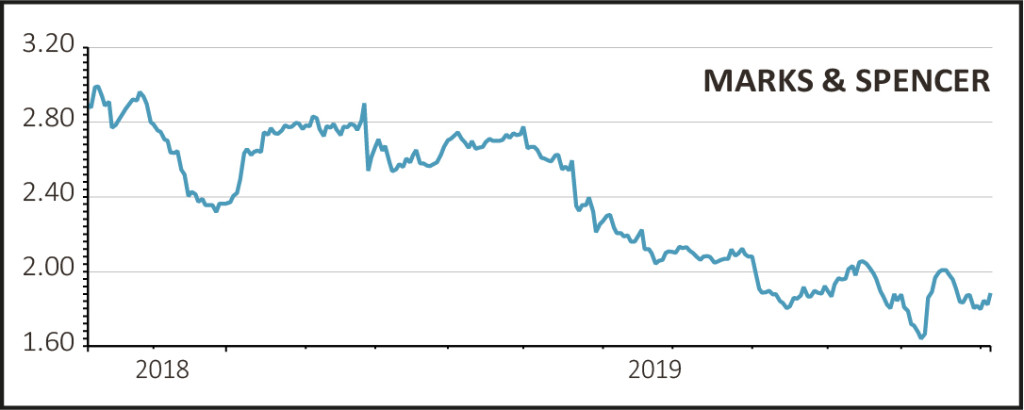Shares in Marks & Spencer (MKS) were marked up 5.3% to 192p after the high street bellwether reported a turnaround plan ‘running at pace’, a pick-up in October clothing sales and kept full year profit guidance unchanged with more cost-cutting to offset gross margin pressure.
However, a 17% plunge in first half pre-tax profit proves there is still much more for management to do to revive the fortunes of the fallen British retail institution.
TALE OF TWO DIVISIONS
Results for the half ended 28 September, breathlessly headlined ‘Far Reaching Change - Delivered At Pace’, showed pre-tax profit slipping 17.1% lower to £176.5m due to weak first-half clothing and home sales, down 5.5% on a like-for-like basis, amid supply chain issues and the purchase of too much stock.
Encouragingly, Marks & Spencer outperformed the market in food, with like-for-like sales up 0.9% against forecasts of 0.3% driven by volume as prices were cut, and flagged an ‘improved sales performance’ in October in the clothing and home division, the retailer’s long-running Achilles heel.
Disappointingly, online revenue grew by a meagre 0.2% due to availability and product mix issues and international revenue declined 1.7% amid trading challenges in Hong Kong and the Republic of Ireland and lower shipments to overseas franchise operators.
ROWE SOUNDS UPBEAT
Marks & Spencer expects to see some improvement in second half trading, although market conditions ‘remain challenging’.
Nevertheless, chief executive Steve Rowe sounded upbeat today, insisting ‘our transformation plan is now running at a pace and scale not seen before at Marks & Spencer. For the first time we are beginning to see the potential from the far reaching changes we are making. The food business is outperforming the market. Our deal to create a joint venture with Ocado (OCDO) is complete and plans to transition to the M&S range are on track.’
In clothing and home, he says Marks & Spencer is ‘making up for lost time. We are still in the early stages, but we are clear on the issues we need to fix and, after a challenging first half, we are seeing a positive response to this season’s contemporary styling and better value product.’
READ MORE ABOUT MARKS & SPENCER HERE
Despite today’s modest bounce, shares in Marks & Spencer are down the best part of 70% from their 591.5p five-year peak (seen in May 2015) and were unceremoniously booted out of the FTSE 100 in September.
The stock has been pummelled on dire trading, negative investor sentiment and latterly, by dilution resulting from the new shares issued under a £583.2m rights issue to fund the acquisition of a 50% share in Ocado Retail.
THE EXPERTS’ VIEW
Commenting on the half-year figures, AJ Bell investment director Russ Mould said: ‘The disappointments are piling up for Marks & Spencer like unsold sweaters and cardigans on its shelves. Fresh from the surprise departure of its finance chief and its relegation from the FTSE 100 for the first time in September, the company has served up a mixed set of first half results.
‘The theme is broadly the same as it has been for years, food has done well but the clothing and home business is struggling - although a combination of low expectations and slightly improved recent trading helped give a bombed out share price a bit of a lift.’
Forecasting a drop in pre-tax profit from £523m to £481m for the year to March 2020, ahead of a rebound to £501m in 2021, broker Shore Capital wrote: ‘One swallow?, but at least there is a swallow in the sky. More swallows will lead to a major bounce in this very lowly rated stock, shorts note, albeit sustained capital appreciation requires sequentially positive divisional like-for-like sales to us. We welcome, however, the greater pace at scale that is now evident. More to do.’




